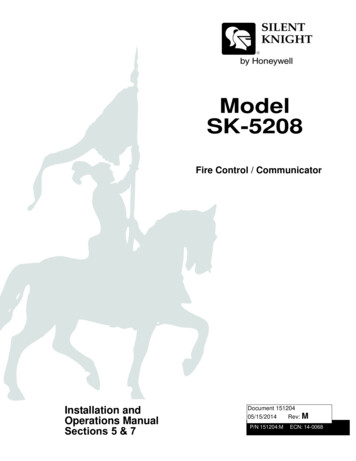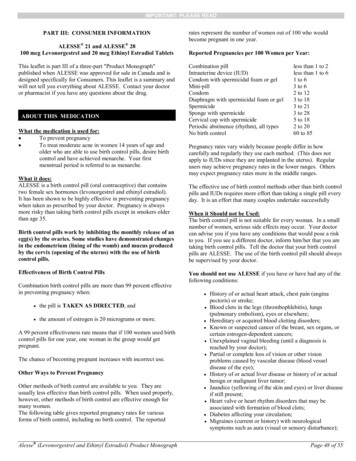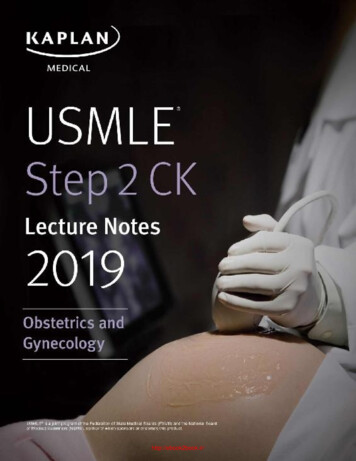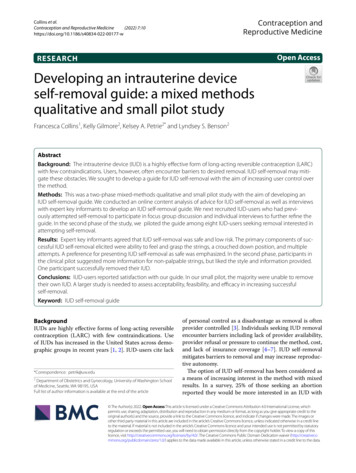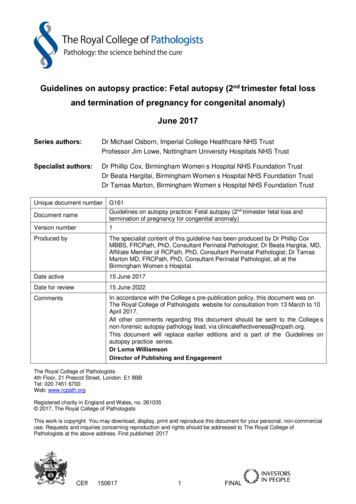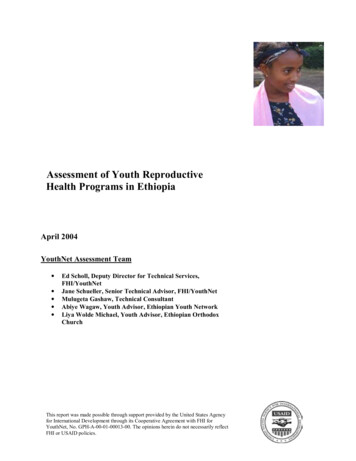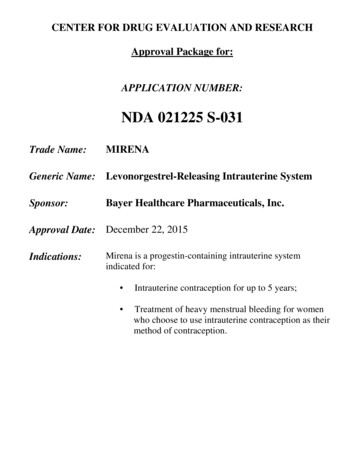
Transcription
CENTER FOR DRUG EVALUATION AND RESEARCHApproval Package for:APPLICATION NUMBER:NDA 021225 S-031Trade Name:MIRENAGeneric Name: Levonorgestrel-Releasing Intrauterine SystemSponsor:Bayer Healthcare Pharmaceuticals, Inc.Approval Date: December 22, 2015Indications:Mirena is a progestin-containing intrauterine systemindicated for: Intrauterine contraception for up to 5 years; Treatment of heavy menstrual bleeding for womenwho choose to use intrauterine contraception as theirmethod of contraception.
CENTER FOR DRUG EVALUATION ANDRESEARCHAPPLICATION NUMBER:NDA 021225 S-031CONTENTSReviews / Information Included in this NDA Review.Approval LetterOther Action LettersLabelingSummary ReviewOfficer/Employee ListOffice Director MemoCross Discipline Team Leader ReviewMedical Review(s)Chemistry Review(s)Environmental AssessmentPharmacology Review(s)Statistical Review(s)Microbiology Review(s)Clinical Pharmacology/Biopharmaceutics Review(s)Risk Assessment and Risk Mitigation Review(s)Proprietary Name Review(s)Other Review(s)Administrative/Correspondence Document(s)XXXXXX
CENTER FOR DRUG EVALUATION ANDRESEARCHAPPLICATION NUMBER:NDA 021225 S-031APPROVAL LETTER
DEPARTMENT OF HEALTH AND HUMAN SERVICESFood and Drug AdministrationSilver Spring MD 20993NDA 021225/S-031SUPPLEMENT APPROVALBayer Healthcare Pharmaceuticals, Inc.Attention: Jo-Ann M. RuaneDeputy Director, Global Regulatory AffairsP.O. Box 915Whippany, NJ 07981-0915Dear Ms. Ruane:Please refer to your Supplemental New Drug Application (sNDA) dated and received March 13,2012, submitted under section 505(b) of the Federal Food, Drug, and Cosmetic Act (FDCA) forMirena (levonorgestrel-releasing intrauterine system).We acknowledge receipt of your amendment dated August 23, 2013, June 25, 2014, July 6, July23, October 9, and October 19, 2015.This “Prior Approval” supplemental new drug application provides for changes to theWARNINGS and PRECAUTIONS SECTION, Subsections on Irregular Bleeding and Amenorrhea andon Ovarian Cysts, and the ADVERSE REACTIONS SECTION, Subsection on Clinical TrialExperience, and USE IN SPECIAL POPULATION, Subsection on Pregnancy.In addition, this supplement includes FDA-requested changes to the WARNINGS andPRECAUTIONS SECTION, Subsection on Breast Cancer, to clarify that more than two observationalstudies of the risk of breast cancer and Mirena have been conducted, and in the ADVERSEREACTIONS SECTION, Subsection on Postmarketing Experience, to indicate that arterialthrombotic and venous thromboembolic events have been reported.APPROVAL & LABELINGWe have completed our review of this supplemental application, as amended. It is approved,effective on the date of this letter, for use as recommended in the enclosed, agreed-upon labelingtext.CONTENT OF LABELINGAs soon as possible, but no later than 14 days from the date of this letter, submit the content oflabeling [21 CFR 314.50(l)] in structured product labeling (SPL) format using the FDAReference ID: 3837008
NDA 021225/S-031Page 2automated drug registration and listing system (eLIST), as described ucturedProductLabeling/default.htm. Contentof labeling must be identical to the enclosed labeling (text for the package insert, text for thepatient package insert), with the addition of any labeling changes in pending “Changes BeingEffected” (CBE) supplements, as well as annual reportable changes not included in the enclosedlabeling.Information on submitting SPL files using eList may be found in the guidance for industry titled“SPL Standard for Content of Labeling Technical Qs and As he SPL will be accessible from publicly available labeling repositories.Also within 14 days, amend all pending supplemental applications that includes labeling changesfor this NDA, including CBE supplements for which FDA has not yet issued an action letter,with the content of labeling [21 CFR 314.50(l)(1)(i)] in MS Word format, that includes thechanges approved in this supplemental application, as well as annual reportable changes andannotate each change. To facilitate review of your submission, provide a highlighted or markedup copy that shows all changes, as well as a clean Microsoft Word version. The marked-up copyshould provide appropriate annotations, including supplement number(s) and annual reportdate(s).REQUIRED PEDIATRIC ASSESSMENTSUnder the Pediatric Research Equity Act (PREA) (21 U.S.C. 355c), all applications for newactive ingredients, new indications, new dosage forms, new dosing regimens, or new routes ofadministration are required to contain an assessment of the safety and effectiveness of theproduct for the claimed indication(s) in pediatric patients unless this requirement is waived,deferred, or inapplicable.Because none of these criteria apply to your application, you are exempt from this requirement.REPORTING REQUIREMENTSWe remind you that you must comply with reporting requirements for an approved NDA(21 CFR 314.80 and 314.81).Reference ID: 3837008
NDA 021225/S-031Page 3If you have any questions, call Charlene Williamson, Regulatory Project Manager, at (301) 7961025.Sincerely,{See appended electronic signature page}Christine Nguyen, M.D.Deputy Director for SafetyDivision of Bone, Reproductive and Urologic ProductsOffice of Drug Evaluation IIICenter for Drug Evaluation and ResearchENCLOSURE:Content of LabelingReference ID: 3837008
----This is a representation of an electronic record that was signedelectronically and this page is the manifestation of the ----------------------------CHRISTINE P NGUYEN10/22/2015Reference ID: 3837008
CENTER FOR DRUG EVALUATION ANDRESEARCHAPPLICATION NUMBER:NDA 021225 S-031LABELING
HIGHLIGHTS OF PRESCRIBING INFORMATIONThese highlights do not include all the information needed to useMIRENA safely and effectively. See full prescribing information forMIRENA.MIRENA (levonorgestrel-releasing intrauterine system)Initial U.S. Approval: 2000 -----------------------WARNINGS AND PRECAUTIONS----------------------- ----------------------------INDICATIONS AND USAGE--------------------------Mirena is a progestin-containing intrauterine system indicated for: Intrauterine contraception for up to 5 years (1) Treatment of heavy menstrual bleeding for women who choose to useintrauterine contraception as their method of contraception. (1)It is recommended for women who have had at least one child.----------------------DOSAGE AND ADMINISTRATION---------------------- Initial release rate of levonorgestrel (LNG) is 20 mcg/day; this rate is reduced byabout 50% after 5 years; Mirena must be removed or replaced after 5 years. (2)To be inserted by a trained healthcare provider using strict aseptic technique.Follow insertion instructions exactly as described. (2.1)Patient should be re-examined and evaluated 4 to 6 weeks after insertion; then,yearly or more often if indicated. (2.2)---------------------DOSAGE FORMS AND STRENGTHS--------------------- One sterile intrauterine system consisting of a T-shaped polyethyleneframe with a steroid reservoir containing 52 mg levonorgestrel packagedwithin a sterile inserter (3)Increased susceptibility to pelvic infection (4)A previous intrauterine device (IUD) that has not been removed (4)Hypersensitivity to any component of Mirena (4) Remove Mirena if pregnancy occurs with Mirena in place. If pregnancy occurs, there isincreased risk of ectopic pregnancy including loss of fertility, pregnancy loss, septicabortion (including septicemia, shock and death), and premature labor and delivery. (5.1,5 2)Group A streptococcal infection has been reported; strict aseptic technique is essentialduring insertion. (5 3)Before using Mirena, consider the risks of PID. (5.4)Bleeding patterns become altered, may remain irregular and amenorrhea mayensue. (5.5)Perforation may occur and may reduce contraceptive effectiveness. Risk isincreased if inserted in lactating women and may be increased if inserted inwomen with fixed retroverted uteri and postpartum. (5.6)Partial or complete expulsion may occur. (5.7)Evaluate persistent enlarged ovarian follicles or ovarian cysts. (5.8)------------------------------ADVERSE REACTIONS------------------------------The most common adverse reactions ( 10% users) are alterations of menstrualbleeding patterns, abdominal/pelvic pain, amenorrhea, headache/migraine,genital discharge, and vulvovaginitis. (6.1)To report SUSPECTED ADVERSE REACTIONS, contact BayerHealthCare Pharmaceuticals Inc. at 1-888-842-2937 or FDA at 1-800FDA-1088 or ----------------------------DRUG INTERACTIONS------------------------------- Pregnancy or suspicion of pregnancy. Cannot be used for post-coitalcontraception (4).Congenital or acquired uterine anomaly if it distorts the uterine cavity (4)Acute pelvic inflammatory disease (PID) or a history of PID unless there hasbeen a subsequent intrauterine pregnancy (4)Postpartum endometritis or infected abortion in the past 3 months (4)Known or suspected uterine or cervical neoplasia (4)Known or suspected breast cancer or other progestin-sensitive cancer (4)Uterine bleeding of unknown etiology (4)Untreated acute cervicitis or vaginitis or other lower genital tract infections (4)Acute liver disease or liver tumor (benign or malignant) (4)Drugs or herbal products that induce certain enzymes, such as CYP3A4, maydecrease the serum concentration of progestins. (7)-----------------------USE IN SPECIFIC POPULATIONS----------------------- Small amounts of progestins pass into breast milk resulting in detectable steroidlevels in infant serum. (8.3)See 17 for PATIENT COUNSELING INFORMATION and FDA-approvedpatient labelingRevised: 10/2015FULL PRESCRIBING INFORMATION: CONTENTS*1 INDICATIONS AND USAGE2 DOSAGE AND ADMINISTRATION2.1. Insertion Instructions2.2 Patient Follow-up2.3 Removal of Mirena2.4 Continuation of Contraception after Removal3 DOSAGE FORMS AND STRENGTHS4 CONTRAINDICATIONS5 WARNINGS AND PRECAUTIONS5.1 Ectopic Pregnancy5.2 Intrauterine Pregnancy5.3 Sepsis5.4 Pelvic Infection5.5 Irregular Bleeding and Amenorrhea5.6 Perforation5.7 Expulsion5.8 Ovarian Cysts5.9 Breast Cancer5.10 Clinical Considerations for Use and Removal6 ADVERSE REACTIONS6.1 Clinical Trials Experience6.2 Postmarketing Experience7 DRUG INTERACTIONS8 USE IN SPECIFIC POPULATIONS8.1 Pregnancy8.3 Nursing Mothers8.4 Pediatric Use8.5 Geriatric Use8.6 Hepatic Impairment8.7 Renal Impairment11 DESCRIPTION11.1 Mirena11.2 Inserter12 CLINICAL PHARMACOLOGY12.1 Mechanism of Action12.2 Pharmacodynamics12.3 Pharmacokinetics13 NONCLINICAL TOXICOLOGY13.1 Carcinogenesis, Mutagenesis, Impairment of Fertility14 CLINICAL STUDIES14.1 Clinical Trials on Contraception14.2 Clinical Trial on Heavy Menstrual Bleeding15 REFERENCES16 HOW SUPPLIED/STORAGE AND HANDLING17 PATIENT COUNSELING INFORMATION*Sections or subsections omitted from the full prescribing informationare not listed1Reference ID: 3837008
FULL PRESCRIBING INFORMATION1 INDICATIONS AND USAGE Mirena is indicated for intrauterine contraception for up to 5 years. Mirena is also indicated for the treatment of heavy menstrual bleeding in women who choose to use intrauterinecontraception as their method of contraception.Mirena is recommended for women who have had at least one child.The system should be replaced after 5 years if continued use is desired.2 DOSAGE AND ADMINISTRATIONMirena contains 52 mg of levonorgestrel (LNG). Initially, LNG is released at a rate of approximately 20 mcg/day. Thisrate decreases progressively to half that value after 5 years.Mirena must be removed by the end of the fifth year and can be replaced at the time of removal with a new Mirena ifcontinued contraceptive protection is desired.Mirena is supplied within an inserter in a sterile package (see Figure 1) that must not be opened until required for insertion[see Description (11.2)]. Do not use if the seal of the sterile package is broken or appears compromised. Use strict aseptictechniques throughout the insertion procedure [see Warnings and Precautions (5.3)].2.1. Insertion Instructions A complete medical and social history should be obtained to determine conditions that might influence the selection of alevonorgestrel-releasing intrauterine system (LNG IUS) for contraception. If indicated, perform a physical examination, andappropriate tests for any forms of genital or other sexually transmitted infections. [See Contraindications (4) and Warningsand Precautions (5.10).]2Reference ID: 3837008
Follow the insertion instructions exactly as described in order to ensure proper placement and avoid premature release ofMirena from the inserter. Once released, Mirena cannot be re-loaded.Mirena should be inserted by a trained healthcare provider. Healthcare providers should become thoroughly familiar with theinsertion instructions before attempting insertion of Mirena.Insertion may be associated with some pain and/or bleeding or vasovagal reactions (for example, syncope, bradycardia), orwith seizure in an epileptic patient, especially in patients with a predisposition to these symptoms. Consider administeringanalgesics prior to insertion.Timing of Insertion Insert Mirena into the uterine cavity during the first seven days of the menstrual cycle or immediately after a first trimesterabortion. Back up contraception is not needed when Mirena is inserted as directed.Postpone postpartum insertion and insertions following second trimester abortions a minimum of six weeks or until the uterusis fully involuted. If involution is delayed, wait until involution is complete before insertion [see Warnings and Precautions(5.6, 5.7)].Tools for InsertionPreparation Gloves Speculum Sterile uterine sound Sterile tenaculum Antiseptic solution, applicatorProcedure Sterile glovesMirena with inserter in sealed packageInstruments and anesthesia for paracervical block, if anticipatedConsider having an unopened backup Mirena availableSterile, sharp curved scissorsPreparation for insertion Exclude pregnancy and confirm that there are no other contraindications to the use of Mirena. Ensure that the patient understands the contents of the Patient Information Booklet and obtain the signed patient informedconsent located on the last page of the Patient Information Booklet.With the patient comfortably in lithotomy position, do a bimanual exam to establish the size, shape and position of the uterus.Gently insert a speculum to visualize the cervix.Thoroughly cleanse the cervix and vagina with a suitable antiseptic solution.Prepare to sound the uterine cavity. Grasp the upper lip of the cervix with a tenaculum forceps and gently apply traction tostabilize and align the cervical canal with the uterine cavity. Perform a paracervical block if needed. If the uterus is retroverted,it may be more appropriate to grasp the lower lip of the cervix. The tenaculum should remain in position and gentle traction onthe cervix should be maintained throughout the insertion procedure.Gently insert a uterine sound to check the patency of the cervix, measure the depth of the uterine cavity in centimeters, confirmcavity direction, and detect the presence of any uterine anomaly. If you encounter difficulty or cervical stenosis, use dilatation,and not force, to overcome resistance. If cervical dilatation is required, consider using a paracervical block.The uterus should sound to a depth of 6 to 10 cm. Insertion of Mirena into a uterine cavity less than 6 cm by soundingmay increase the incidence of expulsion, bleeding, pain, perforation, and possibly pregnancy. 3Reference ID: 3837008
Insertion ProcedureProceed with insertion only after completing the above steps and ascertaining that the patient is appropriate for Mirena. Ensure useof aseptic technique throughout the entire procedure.Step 1–Opening of the package Open the package (Figure 1). The contents of the package are sterile.Figure 1. Opening the Mirena Package Using sterile gloves lift the handle of the sterile inserter and remove from the sterile package.Step 2–Load Mirena into the insertion tube Push the slider forward as far as possible in the direction of the arrow thereby moving the insertion tube over the Mirena Tbody to load Mirena into the insertion tube (Figure 2). The tips of the arms will meet to form a rounded end that extendsslightly beyond the insertion tube.Figure 2. Move slider all the way to the forward position to load Mirena Maintain forward pressure with your thumb or forefinger on the slider. DO NOT move the slider downward at thistime as this may prematurely release the threads of Mirena. Once the slider is moved below the mark, Mirena cannotbe re-loaded.4Reference ID: 3837008
Step 3–Setting the flange Holding the slider in this forward position, set the upper edge of the flange to correspond to the uterine depth (incentimeters) measured during sounding (Figure 3).Figure 3. Setting the flangeStep 4–Mirena is now ready to be inserted Continue holding the slider in this forward position. Advance the inserter through the cervix until the flange is approximately1.5–2 cm from the cervix and then pause (Figure 4).5Reference ID: 3837008
Figure 4. Advancing insertion tube until flange is 1.5 to 2 cm from the cervixDo not force the inserter. If necessary, dilate the cervical canal.Step 5–Open the arms While holding the inserter steady, move the slider down to the mark to release the arms of Mirena (Figure 5). Wait 10 secondsfor the horizontal arms to open completely.6Reference ID: 3837008
Figure 5. Move the slider back to the mark to release and open the armsStep 6–Advance to fundal position Advance the inserter gently towards the fundus of the uterus until the flange touches the cervix. If you encounter fundalresistance do not continue to advance. Mirena is now in the fundal position (Figure 6). Fundal positioning of Mirena isimportant to prevent expulsion.7Reference ID: 3837008
Continue to hold the slider all the way down while you slowly and gently withdraw the inserter from the uterus.Using a sharp, curved scissor, cut the threads perpendicular, leaving about 3 cm visible outside of the cervix [cutting threads atan angle may leave sharp ends (Figure 8)]. Do not apply tension or pull on the threads when cutting to prevent displacingMirena.Figure 8. Cutting the threadsMirena insertion is now complete. Prescribe analgesics, if indicated. Keep a copy of the Consent Form with lot number for yourrecords.Important information to consider during or after insertion If you suspect that Mirena is not in the correct position, check placement (for example, using transvaginal ultrasound).Remove Mirena if it is not positioned completely within the uterus. A removed Mirena must not be re-inserted. If there is clinical concern, exceptional pain or bleeding during or after insertion, appropriate steps (such as physicalexamination and ultrasound) should be taken immediately to exclude perforation.2.2 Patient Follow-up Reexamine and evaluate patients 4 to 6 weeks after insertion and once a year thereafter, or more frequently if clinicallyindicated.2.3 Removal of MirenaTiming of Removal Mirena should not remain in the uterus after 5 years. If pregnancy is not desired, the removal should be carried out during menstruation, provided the woman is stillexperiencing regular menses. If removal will occur at other times during the cycle, consider starting a newcontraceptive method a week prior to removal. If removal occurs at other times during the cycle and the woman hashad intercourse in the week prior to removal, she is at risk of pregnancy. [See Dosage and Administration (2.4).]9Reference ID: 3837008
Tools for RemovalPreparation Gloves SpeculumProcedure Sterile forcepsRemoval Procedure Remove Mirena by applying gentle traction on the threads with forceps. (Figure 9).Figure 9. Removal of Mirena If the threads are not visible, determine location of Mirena by ultrasound [see Warnings and Precautions (5.10)]. If Mirena is found to be in the uterine cavity on ultrasound exam, it may be removed using a narrow forceps, such asan alligator forceps. This may require dilation of the cervical canal. After removal of Mirena, examine the system toensure that it is intact. Removal may be associated with some pain and/or bleeding or vasovagal reactions (for example, syncope, or aseizure in an epileptic patient).2.4 Continuation of Contraception after Removal If pregnancy is not desired and if a woman wishes to continue using Mirena, a new system can be insertedimmediately after removal any time during the cycle. If a patient with regular cycles wants to start a different birth control method, time removal and initiation of new method toensure continuous contraception. Either remove Mirena during the first 7 days of the menstrual cycle and start the newmethod immediately thereafter or start the new method at least 7 days prior to removing Mirena if removal is to occur atother times during the cycle.10Reference ID: 3837008
If a patient with irregular cycles or amenorrhea wants to start a different birth control method, start the new method at least 7days before removal.3 DOSAGE FORMS AND STRENGTHSMirena is a LNG-releasing IUS consisting of a T-shaped polyethylene frame with a steroid reservoir containing a total of52 mg LNG.4 CONTRAINDICATIONSThe use of Mirena is contraindicated when one or more of the following conditions exist: Pregnancy or suspicion of pregnancy; cannot be used for post-coital contraception [see Warnings and Precautions (5.2)]Congenital or acquired uterine anomaly including fibroids if they distort the uterine cavityAcute pelvic inflammatory disease or a history of pelvic inflammatory disease unless there has been a subsequent intrauterinepregnancy [see Warnings and Precautions (5.4)]Postpartum endometritis or infected abortion in the past 3 monthsKnown or suspected uterine or cervical neoplasiaKnown or suspected breast cancer or other progestin-sensitive cancer, now or in the pastUterine bleeding of unknown etiologyUntreated acute cervicitis or vaginitis, including bacterial vaginosis or other lower genital tract infections until infection iscontrolledAcute liver disease or liver tumor (benign or malignant)Conditions associated with increased susceptibility to pelvic infections [see Warnings and Precautions (5.4 )]A previously inserted intrauterine device (IUD) that has not been removedHypersensitivity to any component of this product [see Adverse Reactions (6.2)]5 WARNINGS AND PRECAUTIONS5.1 Ectopic PregnancyEvaluate women for ectopic pregnancy if they become pregnant with Mirena in place because the likelihood of apregnancy being ectopic is increased with Mirena. Up to half of pregnancies that occur with Mirena in place are likely tobe ectopic. Also consider the possibility of ectopic pregnancy in the case of lower abdominal pain, especially inassociation with missed periods or if an amenorrheic woman starts bleeding.The incidence of ectopic pregnancy in clinical trials with Mirena, which excluded women with a history of ectopicpregnancy, was approximately 0.1% per year. The risk of ectopic pregnancy, in women who have a history of ectopicpregnancy and use Mirena is unknown. Women with a previous history of ectopic pregnancy, tubal surgery or pelvicinfection carry a higher risk of ectopic pregnancy. Ectopic pregnancy may result in loss of fertility.5.2 Intrauterine PregnancyIf pregnancy occurs while using Mirena, remove Mirena because leaving it in place may increase the risk of spontaneousabortion and preterm labor. Removal of Mirena or probing of the uterus may also result in spontaneous abortion. In theevent of an intrauterine pregnancy with Mirena, consider the following:Septic abortionIn patients becoming pregnant with an IUD in place, septic abortion - with septicemia, septic shock, and death - mayoccur.Continuation of pregnancyIf a woman becomes pregnant with Mirena in place and if Mirena cannot be removed or the woman chooses not to have itremoved, warn her that failure to remove Mirena increases the risk of miscarriage, sepsis, premature labor and prematuredelivery. Follow her pregnancy closely and advise her to report immediately any symptom that suggests complications ofthe pregnancy.11Reference ID: 3837008
Long-term effects and congenital anomaliesWhen pregnancy continues with Mirena in place, long-term effects on the offspring are unknown. Congenital anomaliesin live births have occurred infrequently. No clear trend towards specific anomalies has been observed. Because of thelocal exposure of the fetus to LNG, the possibility of teratogenicity following exposure to Mirena cannot be completelyexcluded. Some observational data support a small increased risk of masculinization of the external genitalia of the femalefetus following exposure to progestins at doses greater than those currently used for oral contraception. Whether thesedata apply to Mirena is unknown.5.3 SepsisSevere infection or sepsis, including Group A streptococcal sepsis (GAS), have been reported following insertion ofMirena. In some cases, severe pain occurred within hours of insertion followed by sepsis within days. Because death fromGAS is more likely if treatment is delayed, it is important to be aware of these rare but serious infections. Aseptictechnique during insertion of Mirena is essential in order to minimize serious infections such as GAS.5.4 Pelvic InfectionPelvic Inflammatory Disease (PID)Mirena is contraindicated in the presence of known or suspected PID or in women with a history of PID unless there hasbeen a subsequent intrauterine pregnancy [see Contraindications (4)]. IUDs have been associated with an increased riskof PID, most likely due to organisms being introduced into the uterus during insertion. In clinical trials, total combinedupper genital infections were reported in 3.5% of Mirena users. More specifically, endometritis was reported in 2.1%, PIDin 0.6%, and all other upper genital infections in 0.5% of women overall. These infections occurred more frequentlywithin the first year. In a clinical trial with other IUDs1 and a clinical trial with an IUD similar to Mirena, the highest rateoccurred within the first month after insertion.Promptly examine users with complaints of lower abdominal or pelvic pain, odorous discharge, unexplained bleeding,fever, genital lesions or sores. Remove Mirena in cases of recurrent endometritis or PID, or if an acute pelvic infection issevere or does not respond to treatment.Women at increased risk for PIDPID is often associated with a sexually transmitted infection, and Mirena does not protect against sexually transmittedinfection. The risk of PID is greater for women who have multiple sexual partners, and also for women whose sexualpartner(s) have multiple sexual partners. Women who have had PID are at increased risk for a recurrence or re-infection.In particular, ascertain whether the woman is at increased risk of infection (for example, leukemia, acquired immunedeficiency syndrome [AIDS], IV drug abuse).Asymptomatic PIDPID may be asymptomatic but still result in tubal damage and its sequelae.Treatment of PIDFollowing a diagnosis of PID, or suspected PID, bacteriologic specimens should be obtained and antibiotic therapy shouldbe initiated promptly. Removal of Mirena after initiation of antibiotic therapy is usually appropriate. Guidelines for PIDtreatment are available from the Centers for Disease Control (CDC), Atlanta, Georgia.ActinomycosisActinomycosis has been associated with IUDs. Symptomatic women should have Mirena removed and should receiveantibiotics. The significance of actinomyces-like organisms on Pap smear in an asymptomatic IUD user is unknown, andso this finding alone does not always require Mirena removal and treatment. When possible, confirm a Pap smeardiagnosis with cultures.5.5 Irregular Bleeding and AmenorrheaMirena can alter the bleeding pattern and result in spotting, irregular bleeding, heavy bleeding, oligomenorrhea andamenorrhea. During the first three to six months of Mirena use, the number of bleeding and spotting days may be12Reference ID: 3837008
increased and bleeding patterns may be irregular. Thereafter the number of bleeding and spotting days usually decreasesbut bleeding may remain irregular. If bleeding irregularities develop during prolonged treatment, appropriate diagnosticmeasures should be taken to rule out endometrial pathology.Amenorrhea develops in approximately 20% of Mirena users by one year. The possibility of pregnancy should beconsidered if menstruation does not occur within six weeks of the onset of previous menstruation. Once pregnancy hasbeen excluded, repeated pregnancy tests are generally not necessary in amenorrheic women unless indicated, for example,by other signs of pregnancy or by pelvic pain [see Clinical Studies (14.1)].In most women with heavy menstrual bleeding, the number of bleeding and spotting days may also increase during theinitial months of therapy but usually decrease with continued use; the volume of blood loss per cycle progressivelybecomes reduced [see Clinical Studies (14.2)].5.6 PerforationPerforation (total or partial, including penetration/embedment of Mirena in the uterine wall or cervix) may occur mostoften during insertion, although the perforation may not be detected until sometime later. Perforation may reducecontraceptive efficacy and result in pregnancy. The incidence of perforation during clinical trials, which excluded breastfeeding women, was 0.1%.If
Whippany, NJ 07981-0915 Dear Ms. Ruane: Please refer to your Supplemental New Drug Application (sNDA) dated and received March 13, 2012, submitted under section 505(b) of the Federal Food, Drug, and Cosmetic Act (FDCA) for Mirena (levonorgestrel-releasing intrauterine system).
